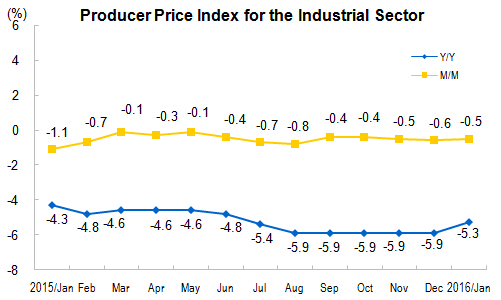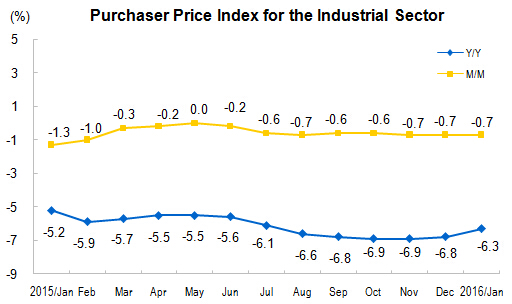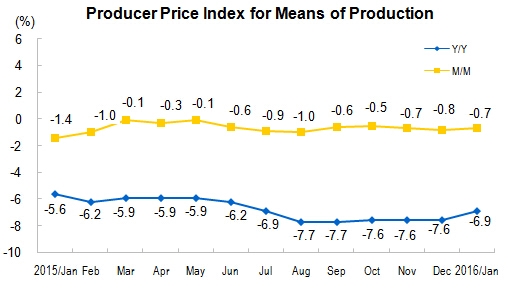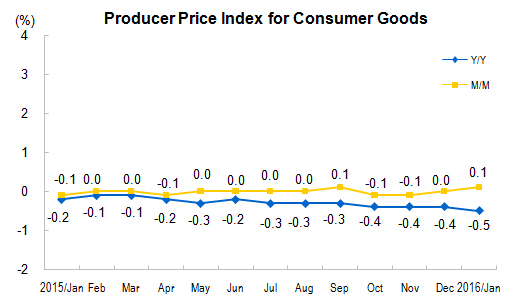Producer Prices for the Industrial Sector for January 2016
In January 2016, Producer Price Index (PPI) for manufactured goods decreased 0.5 percent month-on-month, and decreased 5.3 percent year-on-year. The purchasing price index for manufactured goods decreased 0.7 percent month-on-month, and decreased 6.3 percent year-on-year.


1. Year-on-Year Changes of Prices of Different Categories
The year-on-year change of producer prices for means of production decreased 6.9 percent, meaning 5.2 percentage points decrease in the overall price level. Of which, producer prices for mining and quarrying industry decreased 19.8 percent; that of raw materials industry decreased 9.1 percent; that of manufacturing and processing industry decreased 4.9 percent. Producer prices for consumer goods went down by 0.5 percent year-on-year, meaning 0.1 percentage point decrease in the overall price level. Of which, producer prices for foodstuff increased 0.2 percent, that of clothing increased 0.7 percent, that of commodities decreased 1.2 percent, and that of durable consumer goods dropped by 1.6 percent.


According to estimation, in the -5.3 percent decreases in January, the carryover effect of last year’s prices changing was -4.8 percentage points, while new prices rising factors accounted for -0.5 percentage points.
The year-on-year purchaser price indices for ferrous metal materials decreased 13.6 percent, fuel and power decreased 10.7 percent, non-ferrous metal materials and wires fell by 10.4 percent, chemical raw materials went down by 5.7 percent.
2. Month-on-Month Changes of Prices of Different Categories
The producer prices for means of production decreased 0.7 percent month-on-month, meaning 0.5 percentage points decrease in the overall price level. Of the total, producer prices for mining and quarrying industry went down by 4.3 percent, that of raw materials industry decreased 1.1 percent, that of manufacturing and processing industry decreased 0.2 percent. Producer prices for consumer goods increased 0.1 percent month-on-month. Of which, producer prices for foodstuff increased 0.2 percent, that of clothing increased 0.3 percent, that of commodities increased 0.1 percent, and that of durable consumer goods decreased 0.1 percent.
The month-on-month purchaser price indices for fuel and power decreased 1.9 percent, that of ferrous metal materials decreased 1.1 percent, that of non-ferrous metal materials and wires went down by 0.4 percent, that of agricultural and sideline products increased 0.3 percent.
Price Indexes for the Industrial Sector in January
|
| January | |
| M/M(%) | Y/Y(%) | |
|
|
|
|
| I. Producer Price Indices | -0.5 | -5.3 |
| Means of production | -0.7 | -6.9 |
| Mining and quarrying | -4.3 | -19.8 |
| Raw materials | -1.1 | -9.1 |
| Processing | -0.2 | -4.9 |
| Means of subsistence | 0.1 | -0.5 |
| Food | 0.2 | 0.2 |
| Clothing | 0.3 | 0.7 |
| Articles for daily use | 0.1 | -1.2 |
| Durable consumer goods | -0.1 | -1.6 |
|
|
|
|
| II. Purchaser Price Indices | -0.7 | -6.3 |
| Fuel and Power | -1.9 | -10.7 |
| Ferrous Metals | -1.1 | -13.6 |
| Non-ferrous Metal Materials and Wires | -0.4 | -10.4 |
| Chemical Raw Materials | -0.7 | -5.7 |
| Wood and Pulp | -0.1 | -0.5 |
| Building Materials and Non-metallic | -0.4 | -5.3 |
| Other Industrial Raw Materials and Semi-products | -0.2 | -2.3 |
| Agricultural and Sideline Products | 0.3 | -1.5 |
| Textile Raw Materials | -0.2 | -1.6 |
|
|
|
|
| III. Producer Price Indices of Major Industries |
|
|
| Mining and Washing of Coal | -1.5 | -17.8 |
| Extraction of Petroleum and Natural Gas | -16.6 | -38.3 |
| Mining of Ferrous Metal Ores | -2.5 | -18.9 |
| Mining of Non-Ferrous Metal Ores | 0.6 | -10.1 |
| Mining and Processing of Nonmetal Ores | 0.1 | -1.7 |
| Processing of Food from Agricultural Products | 0.2 | -1.0 |
| Manufacture of Foods | 0.0 | -0.2 |
| Manufacture of Wines, Beverage and Refined Tea | -0.1 | -0.5 |
| Manufacture of Cigarettes and Tobacco | 0.0 | 0.1 |
| Manufacture of Textile | -0.4 | -2.9 |
| Manufacture of Textile Wearing Apparel and Ornament | 0.3 | 0.5 |
| Processing of Timbers, Manufacture of Wood, Bamboo, Rattan, Palm, and Straw Products | 0.2 | -0.7 |
| Manufacture of Paper and Paper Products | -0.1 | -1.0 |
| Printing, Reproduction of Recording Media | 0.1 | -0.9 |
| Processing of Petroleum, Coking, Processing of Nucleus Fuel | -2.6 | -13.5 |
| Manufacture of Chemical Raw Material and Chemical Products | -0.7 | -6.3 |
| Manufacture of Medicines | 0.4 | 0.3 |
| Manufacture of Chemical Fibers | -1.4 | -9.7 |
| Manufacture of Rubber and Plastics Products | -0.3 | -3.0 |
| Manufacture of Non-metallic Mineral Products | -0.5 | -4.2 |
| Manufacture and Processing of Ferrous Metals | 0.1 | -19.0 |
| Manufacture and Processing of Non-Ferrous Metals | 0.0 | -12.1 |
| Manufacture of Fabricated Metal Products | -0.2 | -4.3 |
| Manufacture of General- Purpose Machinery | -0.2 | -1.6 |
| Manufacture of Motor Vehicles | -0.1 | -1.1 |
| Manufacture of Railway Locomotives, Building of Ships and Boats, Manufacture of Air and Spacecrafts and Other Transportation Equipments | -0.2 | -1.0 |
| Manufacture of Computer, Communication Equipment and Other Electronic Equipment | -0.1 | -1.7 |
| Production and Supply of Electric Power and Heat Power | -1.1 | -3.1 |
| Production and Distribution of Gas | -2.7 | -8.3 |
| Production and Distribution of Water | 0.5 | 1.5 |
|
|
|
|
Annotations:
1. Explanatory Notes
Producer Price Index for manufactured goods consists of producer price index and purchaser price index.
The industrial producer price index reflects the trend and level of prices change when the products are sold for the first time.
The industrial purchaser price index reflects the trend and level of prices change for the products purchased by the industrial enterprises as intermediate inputs.
2. Statistical Coverage
The statistical survey of industrial producer prices covers prices for over 20,000 products from 1638 subclasses; and the statistical surveys of industrial purchaser prices cover prices for over 10,000 industrial products from over 900 subclasses.
3. Survey Methods
Industrial producer prices are collected from combined surveys of key businesses and typical businesses. The key businesses are those with their annual revenue from principal activities over 20 million yuan, and the typical businesses are those with less than 20 million yuan. The surveys cover about 50,000 industrial enterprises in over 400 cities across the country.
4. Rotation of the Base Period
In order to better reflect the latest changes in economic structure, according to the statistical system, the base period of the statistical survey of industrial producer prices was rotated every five years. Since January 2016, the new base period was 2015, and Industrial Classification was still based on the “Industrial Classification for National Economic Activities” (GB/T4754-2011)( http://www.stats.gov.cn/tjsj/tjbz/hyflbz). The weight numbers of large, medium and small classes were accordingly adjusted. According to estimation, the current rotation of the base period had almost no influence on the month-on-month data of PPI, and a little influence on the year-on-year data, which was about 0.002 percentage points.
